

Nacos+@RefreshScope为什么配置能动态刷新?
电子说
描述
概述
RefeshScope这个注解想必大家都用过,在微服务配置中心的场景下经常出现,他可以用来刷新Bean中的属性配置,那大家对他的实现原理了解吗?它为什么可以做到动态刷新呢?
注解的作用
@RefreshScope注解是Spring Cloud中的一个注解,用来实现Bean中属性的动态刷新。
/**
* Convenience annotation to put a @Bean definition in
* {@link org.springframework.cloud.context.scope.refresh.RefreshScope refresh scope}.
* Beans annotated this way can be refreshed at runtime and any components that are using
* them will get a new instance on the next method call, fully initialized and injected
* with all dependencies.
*
* @author Dave Syer
*
*/
@Target({ ElementType.TYPE, ElementType.METHOD })
@Retention(RetentionPolicy.RUNTIME)
@Scope("refresh")
@Documented
public @interface RefreshScope {
/**
* @see Scope#proxyMode()
* @return proxy mode
*/
ScopedProxyMode proxyMode() default ScopedProxyMode.TARGET_CLASS;
}
上面是RefreshScope的源码,该注解被@Scope注解使用,@Scope用来比较Spring Bean的作用域,具体使用参考相关文章。
注解的属性proxyMode默认使用TARGET_CLASS作为代理。
实例
controller中添加@RefreshScope
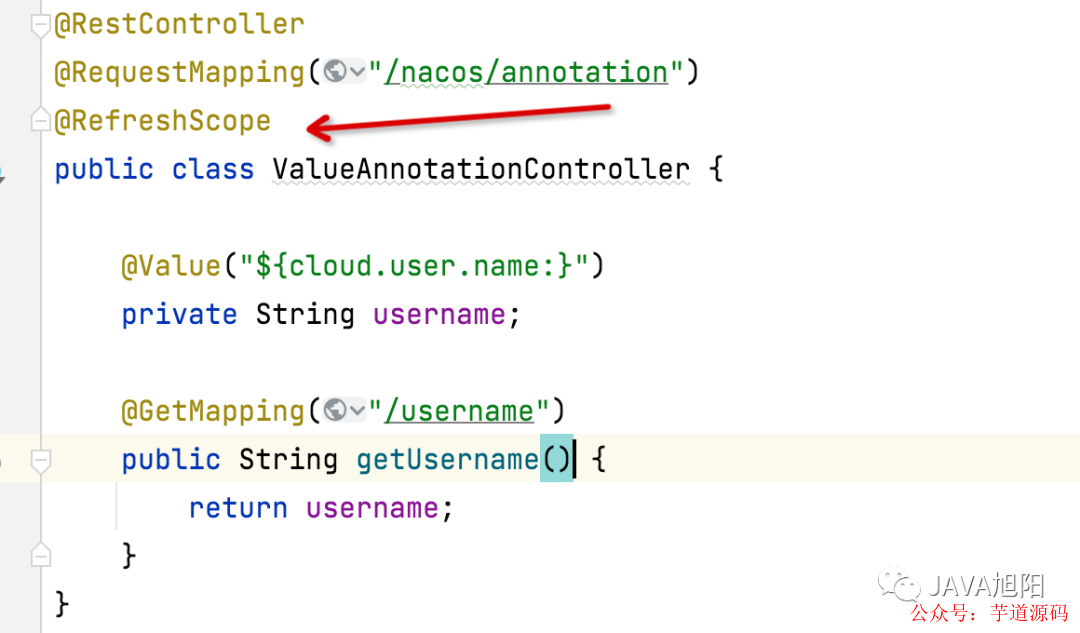
nacos配置中心中配置
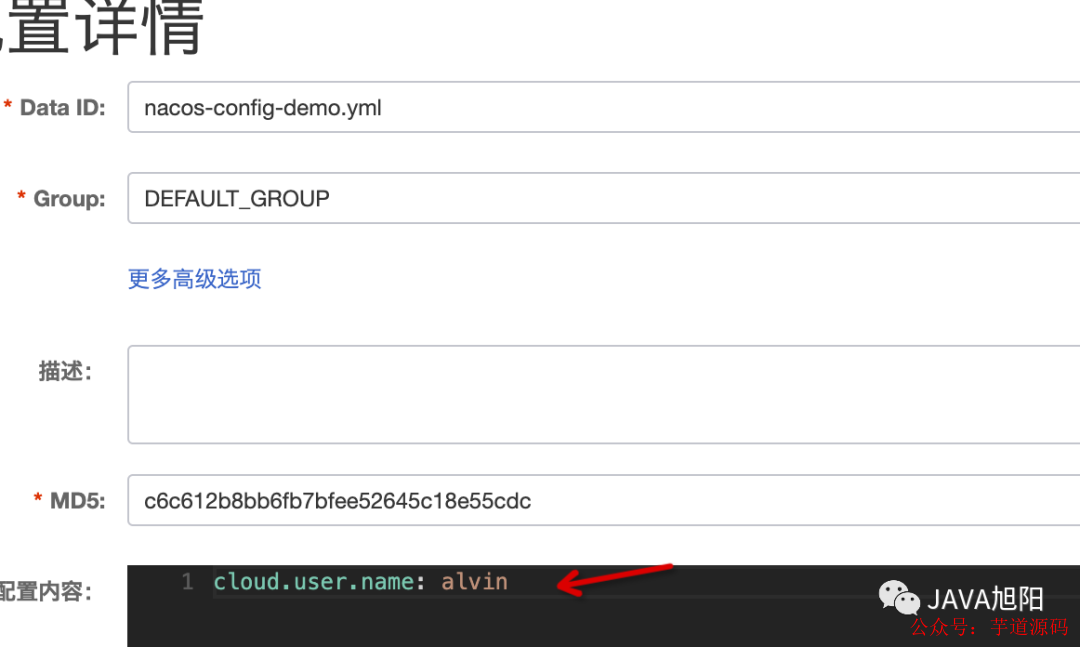
验证, 修改配置中心后,可以不重启动,刷新配置

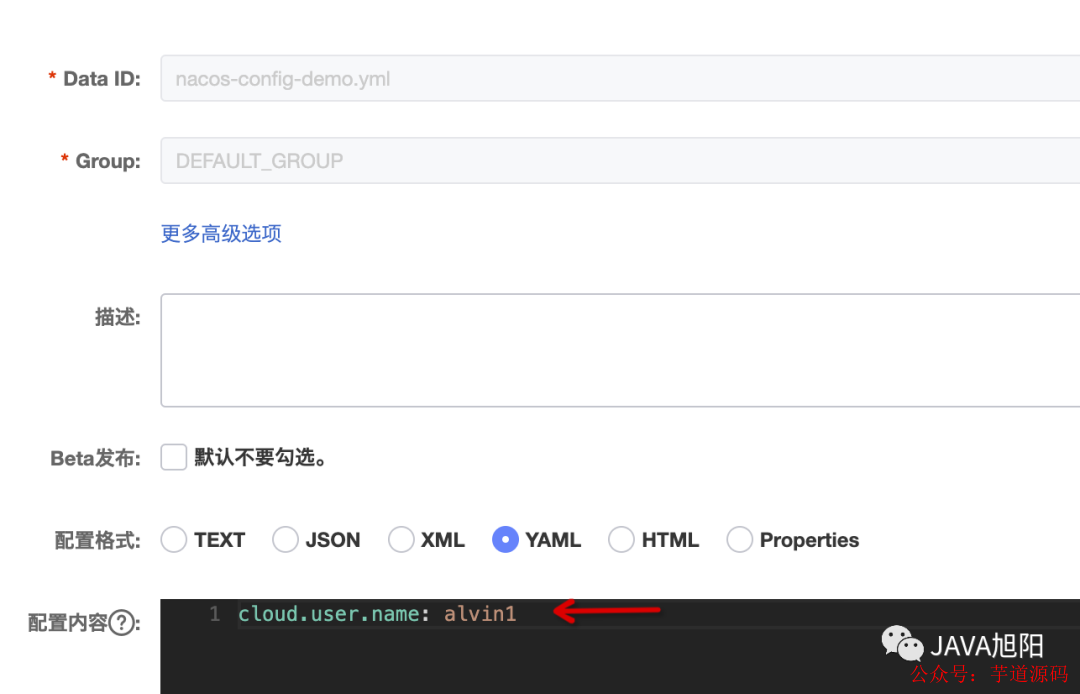

去掉@RefreshScope 就不会自动刷新。
原理解析
为了实现动态刷新配置,主要就是想办法达成以下两个核心目标:
让Spring容器重新加载Environment环境配置变量
Spring Bean重新创建生成
@RefreshScope主要就是基于@Scope注解的作用域代理的基础上进行扩展实现的,加了@RefreshScope注解的类,在被Bean工厂创建后会加入自己的refresh scope 这个Bean缓存中,后续会优先从Bean缓存中获取,当配置中心发生了变更,会把变更的配置更新到spring容器的Environment中,并且同事bean缓存就会被清空,从而就会从bean工厂中创建bean实例了,而这次创建bean实例的时候就会继续经历这个bean的生命周期,使得@Value属性值能够从Environment中获取到最新的属性值,这样整个过程就达到了动态刷新配置的效果。
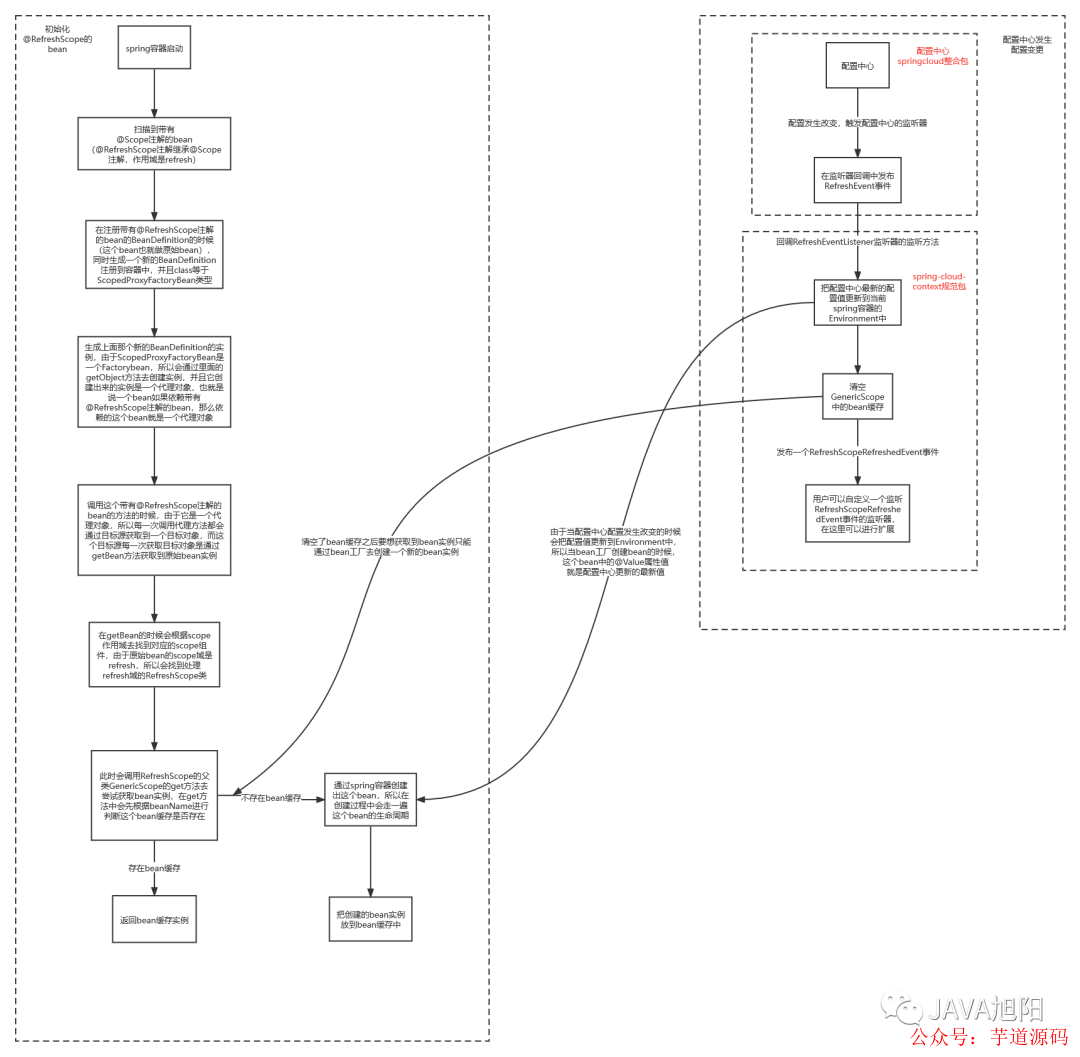
获取RefreshScope注解的Bean
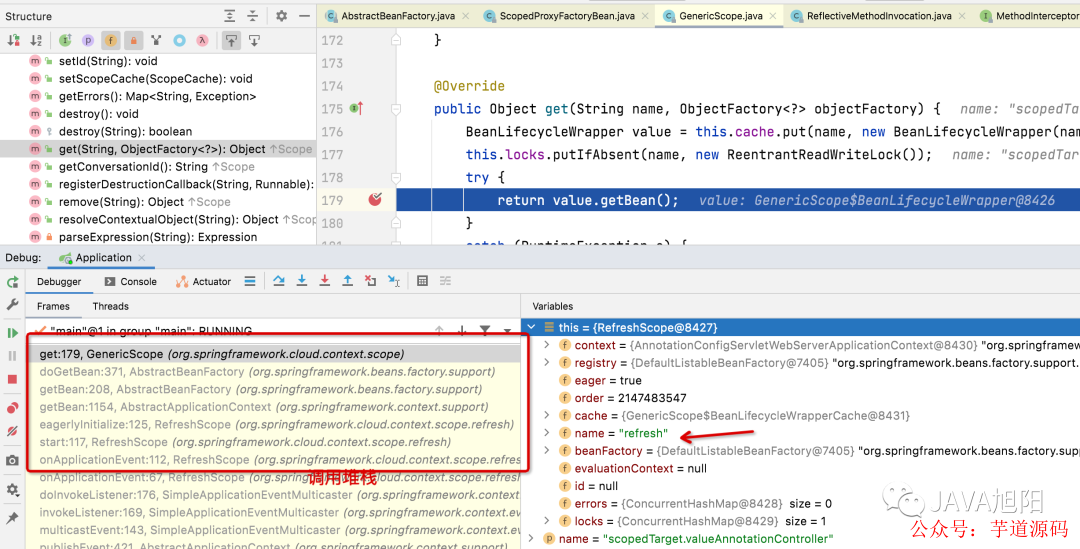
通过打上断点查看堆栈可知:
因为Class被加上了@RefreshScope注解,那么这个BeanDefinition信息中的scope为refresh,在getBean的的时候会单独处理逻辑。
public abstract class AbstractBeanFactory extends FactoryBeanRegistrySupport implements ConfigurableBeanFactory {
protected T doGetBean(
String name, @Nullable Class requiredType, @Nullable Object[] args, boolean typeCheckOnly)
throws BeansException {
// 如果scope是单例的情况, 这里不进行分析
if (mbd.isSingleton()) {
.....
}
// 如果scope是prototype的情况, 这里不进行分析
else if (mbd.isPrototype()) {
......
}
// 如果scope是其他的情况,本例中是reresh
else {
String scopeName = mbd.getScope();
if (!StringUtils.hasLength(scopeName)) {
throw new IllegalStateException("No scope name defined for bean '" + beanName + "'");
}
// 获取refresh scope的实现类RefreshScope,这个类在哪里注入,我们后面讲
Scope scope = this.scopes.get(scopeName);
if (scope == null) {
throw new IllegalStateException("No Scope registered for scope name '" + scopeName + "'");
}
try {
// 这边是获取bean,调用的是RefreshScope中的的方法
Object scopedInstance = scope.get(beanName, () -> {
beforePrototypeCreation(beanName);
try {
return createBean(beanName, mbd, args);
}
finally {
afterPrototypeCreation(beanName);
}
});
beanInstance = getObjectForBeanInstance(scopedInstance, name, beanName, mbd);
}
catch (IllegalStateException ex) {
throw new ScopeNotActiveException(beanName, scopeName, ex);
}
}
}
catch (BeansException ex) {
beanCreation.tag("exception", ex.getClass().toString());
beanCreation.tag("message", String.valueOf(ex.getMessage()));
cleanupAfterBeanCreationFailure(beanName);
throw ex;
}
finally {
beanCreation.end();
}
}
return adaptBeanInstance(name, beanInstance, requiredType);
}
}
2.RefreshScope继承成了GenericScope类,最终调用的的是GenericScope的get方法
public class GenericScope
implements Scope, BeanFactoryPostProcessor, BeanDefinitionRegistryPostProcessor, DisposableBean {
@Override
public Object get(String name, ObjectFactory objectFactory) {
// 将bean添加到缓存cache中
BeanLifecycleWrapper value = this.cache.put(name, new BeanLifecycleWrapper(name, objectFactory));
this.locks.putIfAbsent(name, new ReentrantReadWriteLock());
try {
// 调用下面的getBean方法
return value.getBean();
}
catch (RuntimeException e) {
this.errors.put(name, e);
throw e;
}
}
private static class BeanLifecycleWrapper {
public Object getBean() {
// 如果bean为空,则创建bean
if (this.bean == null) {
synchronized (this.name) {
if (this.bean == null) {
this.bean = this.objectFactory.getObject();
}
}
}
// 否则返回之前创建好的bean
return this.bean;
}
}
}
小结:
从这边的代码中可以印证了上面的说法,创建后的Bean会缓存到scope的cache中,优先从缓存中获取,如果缓存中是null, 则重新走一遍create bean的流程。
RefeshScope Bean的创建
上面的在getBean的时候依赖到RefreshScope这个Bean,那么这个Bean是在什么时候加入到Spring Bean中的呢?答案就是RefreshAutoConfiguration。
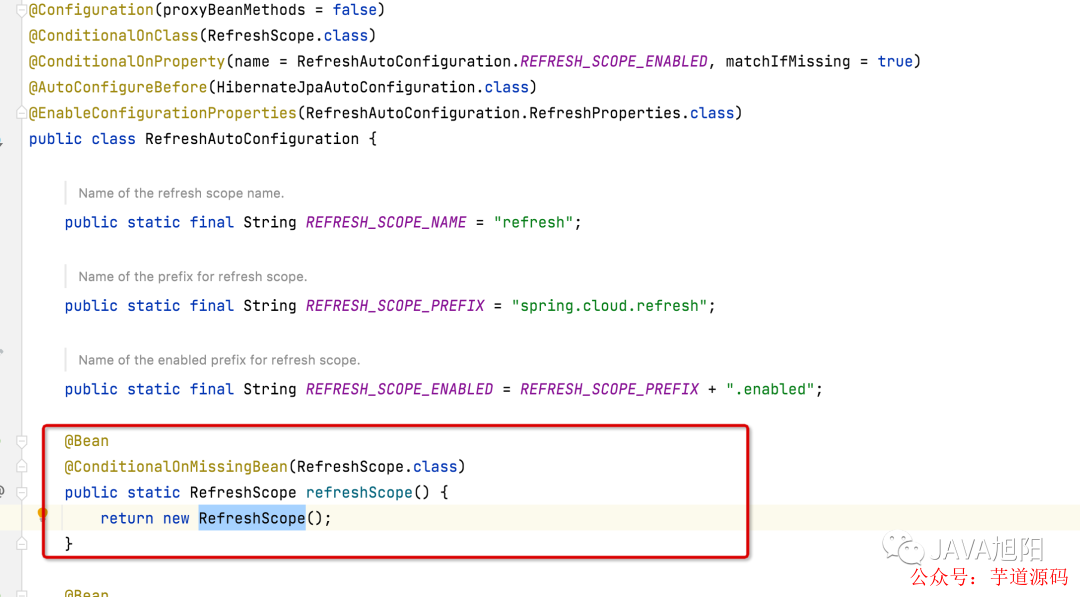
配置中心刷新后刷新Bean缓存
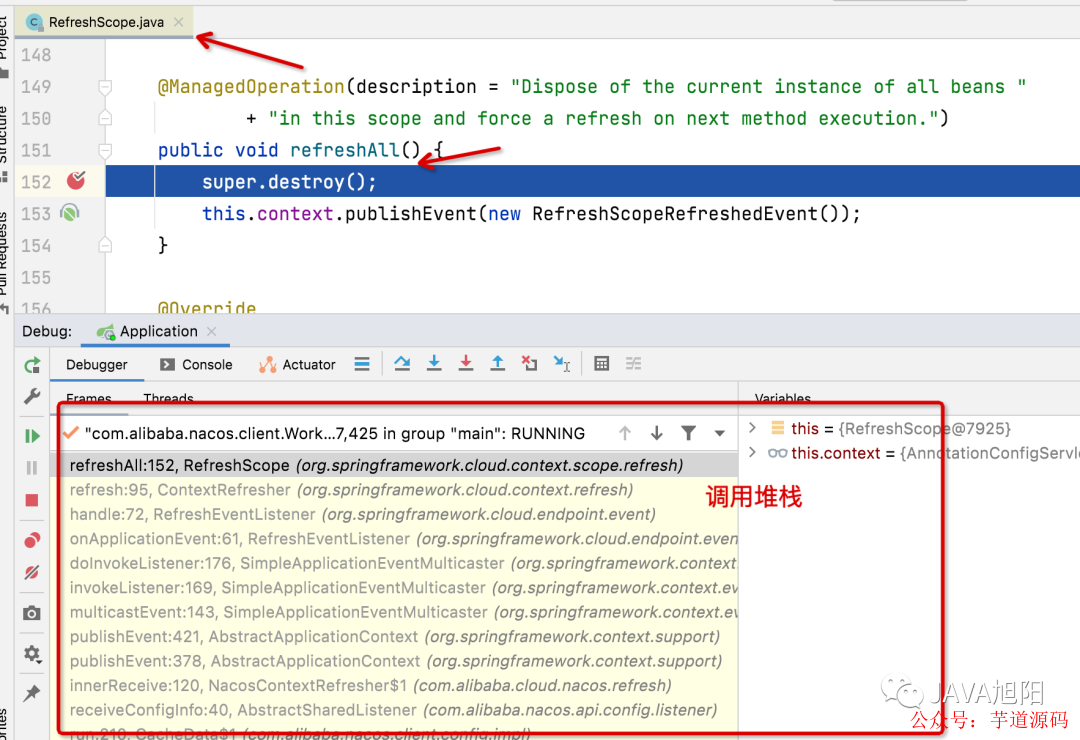
配置中心发生变化后,会收到一个RefreshEvent事件,RefreshEventListner监听器会监听到这个事件。
public class RefreshEventListener implements SmartApplicationListener {
........
public void handle(RefreshEvent event) {
if (this.ready.get()) { // don't handle events before app is ready
log.debug("Event received " + event.getEventDesc());
// 会调用refresh方法,进行刷新
Set keys = this.refresh.refresh();
log.info("Refresh keys changed: " + keys);
}
}
}
// 这个是ContextRefresher类中的刷新方法
public synchronized Set refresh() {
// 刷新spring的envirionment 变量配置
Set keys = refreshEnvironment();
// 刷新其他scope
this.scope.refreshAll();
return keys;
}
refresh方法最终调用destroy方法,清空之前缓存的bean
public class RefreshScope extends GenericScope implements ApplicationContextAware, ApplicationListener, Ordered { @ManagedOperation(description = "Dispose of the current instance of all beans " + "in this scope and force a refresh on next method execution.") public void refreshAll() { // 调用父类的destroy super.destroy(); this.context.publishEvent(new RefreshScopeRefreshedEvent()); } } @Override public void destroy() { List errors = new ArrayList (); Collection wrappers = this.cache.clear(); for (BeanLifecycleWrapper wrapper : wrappers) { try { Lock lock = this.locks.get(wrapper.getName()).writeLock(); lock.lock(); try { // 这里主要就是把之前的bean设置为null, 就会重新走createBean的流程了 wrapper.destroy(); } finally { lock.unlock(); } } catch (RuntimeException e) { errors.add(e); } } if (!errors.isEmpty()) { throw wrapIfNecessary(errors.get(0)); } this.errors.clear(); }
总结
上面是这个RefreshScope实现动态刷新大致的原理,其中里面还有很多细节,可能需要留给大家自己debug去深入理解。
审核编辑:刘清
-
Nacos是什么?Nacos配置管理技巧你知道吗2018-10-29 15419
-
Nacos的概念和功能2023-09-25 3779
-
支持Dubbo生态发展,阿里巴巴启动新的开源项目 Nacos2018-07-05 3769
-
结合场景谈一谈微服务配置2018-12-12 2305
-
构建ARM64版本nacos docker镜像2022-06-16 4294
-
基于71M6515H和双CPU的智能动态分相无功补偿控制器2010-05-12 567
-
基于LabView平台的齿轮箱性能动态测试与诊断_李贵明2017-03-18 806
-
Nacos发布0.5.0版本,轻松玩转动态 DNS 服务2018-12-05 172
-
微服务配置中心实战:Spring + MyBatis + Druid + Nacos2018-12-29 1314
-
Nacos服务地址动态感知原理2022-09-26 2349
-
Nacos为什么这么强?Nacos注册中心的底层原理,从服务注册到服务发现2022-10-08 12453
-
Nacos、Apollo、Config配置中心如何选型?2022-10-31 2028
-
华为云CSE 关键特性,支持托管Nacos注册配置中心2022-12-29 1581
-
基于Nacos的简单动态化线程池实现2023-01-06 1427
-
Nacos实现原理:SpringCloud集成Nacos的实现过程2023-10-09 2527
全部0条评论

快来发表一下你的评论吧 !

